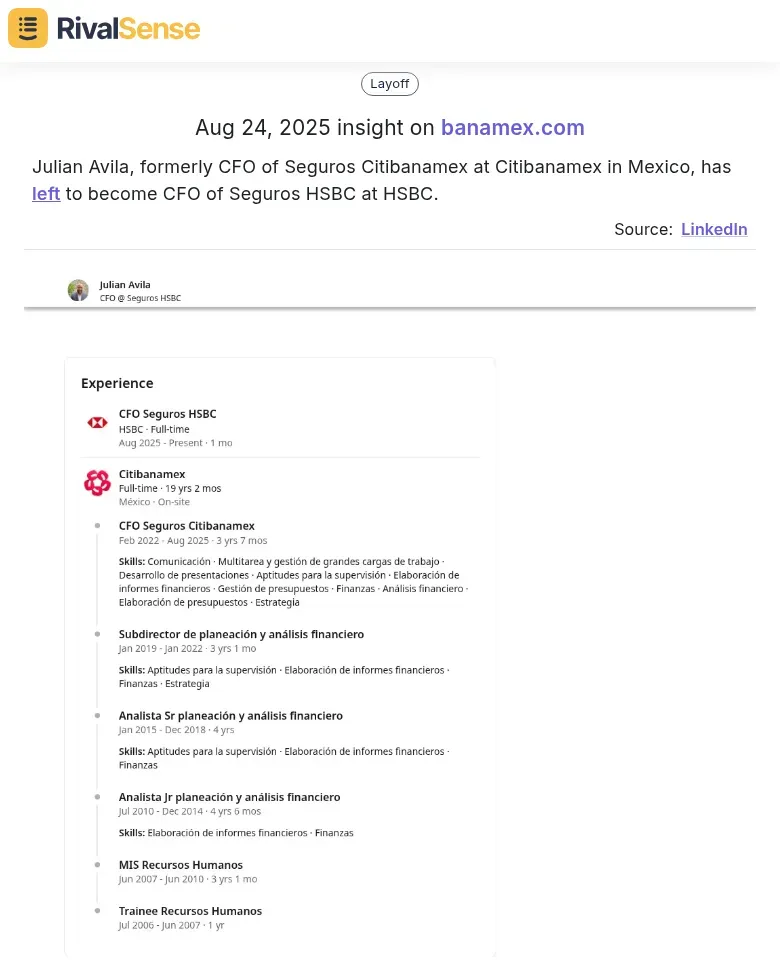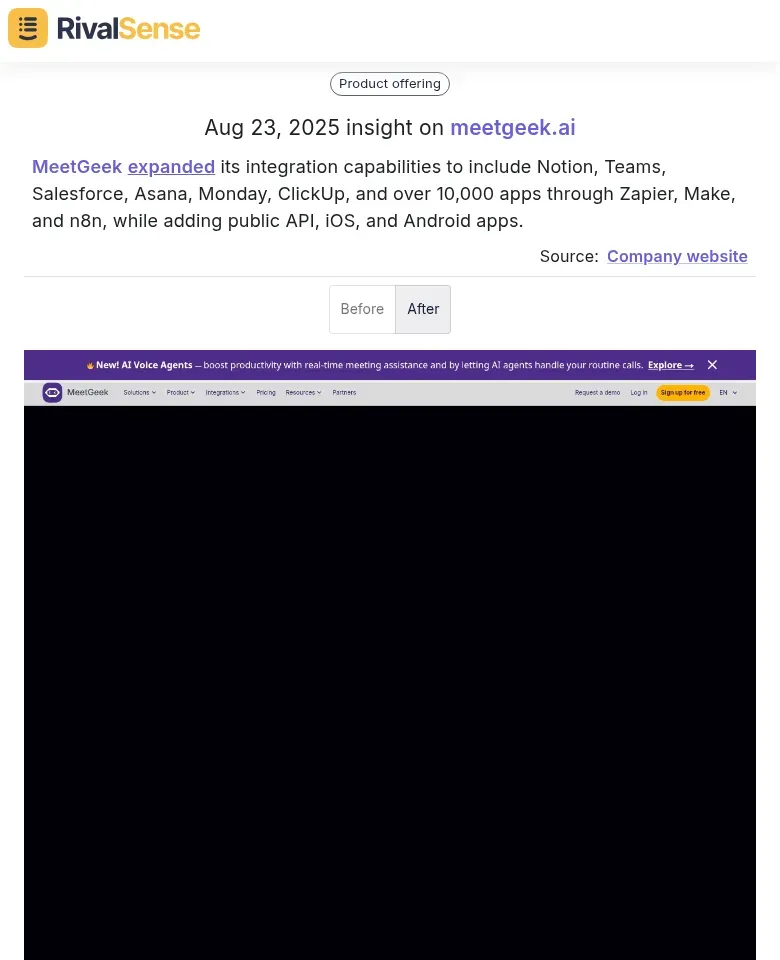Business Partnership Training Programs: Best Practices & 2025 Implementation Guide
In today's competitive business landscape, effective partnership training programs have become a critical component of successful business strategy. Companies with structured partner training programs experience 28% higher partner retention rates and 35% faster revenue growth from partner channels, making them essential for sustainable growth.
Partnership training programs are strategic initiatives designed to educate business partners—whether they're resellers, distributors, consultants, or affiliates—on how to effectively promote, sell, and support your products or services. These programs transform partners into valuable extensions of your team, driving mutual success and market expansion.

Example: Tracking executive movements like Julian Avila's transition from Citibanamex to HSBC can reveal potential partnership opportunities or competitive shifts. Such insights help you anticipate market changes and align your training programs with evolving industry dynamics.
Types of Partnership Training Programs
1. Product Training
At the core of most partnership programs, product training focuses on conveying your product's value proposition, unique selling points, target market, and ideal customer profile. Partners need to understand not just what your product does, but how it solves specific customer problems effectively.
2. Sales Enablement Training
This training equips partners with the tools and knowledge to drive sales success, including sales methodologies, effective pitches, objection handling techniques, and competitive analysis. The goal is transforming partners into skilled sales professionals who can represent your brand effectively.
3. Compliance Training
Essential for regulated industries, compliance training ensures partners follow company policies, data privacy regulations, and industry standards. This protects your business from legal and financial consequences while maintaining brand integrity across all partner interactions.
4. Technical Training
Crucial for partners involved in implementation or support, technical training includes hands-on practice, troubleshooting exercises, and best practices for product usage and security. This ensures partners can deliver quality service and support to end customers.

Example: Monitoring product integration expansions like MeetGeek's recent capabilities update helps understand how competitors are enabling their partners. This intelligence allows you to benchmark your technical training against industry standards and identify gaps in your program.
10-Step Checklist for Implementing Effective Partnership Training Programs
Step 1: Define Clear Training Goals
Before developing your program, determine specific outcomes. Are you aiming for increased sales, improved customer satisfaction, or enhanced brand awareness? Conduct a partner needs assessment to align objectives with actual requirements.
Step 2: Identify Target Partner Segments
Understand your partner ecosystem and tailor training to different segments (resellers, distributors, affiliates). This targeted approach maximizes impact and resource allocation efficiency while addressing specific partner needs.
Step 3: Develop Comprehensive Curriculum
Create structured training modules covering product knowledge, sales enablement, marketing strategies, and compliance. Use a mix of formats—videos, interactive exercises, case studies—to cater to diverse learning styles and preferences.
Step 4: Build Engaging Training Materials
Develop high-quality, visually appealing materials with multimedia elements. Consider incorporating gamification to enhance engagement and retention, making learning more interactive and enjoyable for partners.
Step 5: Choose the Right Delivery Method
Select delivery methods based on your audience, budget, and objectives. Options include instructor-led training, online platforms, webinars, or blended approaches that combine multiple methods for optimal results.
Step 6: Implement Robust Onboarding Process
Create a smooth onboarding experience with clear guidelines, resources, and support. Effective onboarding sets the stage for long-term partner success and retention, making partners feel valued from day one.
Step 7: Provide Ongoing Support and Training
Partner training is a journey, not a one-time event. Offer continuous support through dedicated channels, advanced training, certifications, and specialized workshops to keep partners engaged and updated.
Step 8: Establish Clear KPIs for Measurement
Track key performance indicators including:
- Number of partners enrolled and certified
- Partner satisfaction scores
- Partner program revenue
- Per-partner revenue and profitability
Step 9: Gather and Act on Partner Feedback
Regularly collect feedback through surveys, one-on-one sessions, and review meetings. Use this input to continuously improve your training programs and address partner concerns proactively.
Step 10: Continuously Refine and Optimize
Based on KPIs and feedback, regularly update training materials, enhance product knowledge, and adjust support strategies to keep your program effective and relevant in a changing market.
Best Practices for Partnership Training Success
Align Training with Partner Business Objectives
Ensure your training directly supports partner growth and revenue generation. If a partner focuses on SMB customers, tailor training to that specific segment's needs and challenges for maximum impact.
Create Personalized Learning Journeys
Use a Learning Management System (LMS) with personalization capabilities to offer customized learning paths based on partner size, experience, and goals. This ensures each partner gets relevant training that drives results.
Leverage Multiple Learning Formats
Combine online modules, instructor-led training, webinars, and interactive simulations to cater to different learning styles. Microlearning is ideal for timely information delivery and quick knowledge updates.
Provide Marketing and Sales Support
Offer partners easy access to high-quality, customizable marketing materials rather than overwhelming them with quantity. This enables effective campaign participation and consistent brand messaging.
Monitor Competitive Landscape
Stay aware of how competitors are training their partners. Tracking competitor activities helps you benchmark your program, identify industry standards, and discover innovative approaches to partner education.

Example: Leadership changes like Hoby Darling's appointment at Riot Games can signal strategic shifts in partnership approaches. Monitoring these changes helps you anticipate competitor moves and adjust your training strategy accordingly.
Measuring Success: Key Performance Indicators
Track these essential metrics to evaluate your partnership training effectiveness:
| Metric | Description | Target |
|---|---|---|
| Training Completion Rates | Percentage of partners completing required training | >85% |
| Certification Achievement | Number of partners achieving certification levels | Increasing quarterly |
| Time to Competency | How quickly partners become productive after training | <30 days |
| Partner Satisfaction Scores | Feedback on training quality and relevance | >4/5 score |
| Revenue Impact | Correlation between training and sales performance | 20%+ increase |
| Partner Retention Rates | How training affects partnership sustainability | >90% retention |
Common Pitfalls to Avoid
🚫 One-Size-Fits-All Approach: Different partner segments have different needs and require customized training approaches
🚫 Lack of Ongoing Support: Training shouldn't end after initial onboarding—continuous learning is essential for long-term success
🚫 Poor Measurement: Without proper KPIs, you can't prove program effectiveness or justify continued investment
🚫 Ignoring Feedback: Partners are your best source of improvement ideas—listen and act on their suggestions
🚫 Underestimating Competitive Intelligence: Not monitoring how competitors are training their partners can leave you at a significant disadvantage
How Technology Supports Partnership Training
Modern Learning Management Systems (LMS) provide:
✅ Personalized learning paths tailored to individual partner needs
✅ Multi-format content delivery for flexible learning experiences
✅ Progress tracking and analytics for measurable results
✅ Automated certifications and reminders for consistent engagement
✅ Scalable training for growing partner networks
Competitive intelligence platforms like RivalSense complement training programs by providing real-time insights into competitor partnership strategies, training content updates, and market positioning. This intelligence helps you stay ahead of industry trends and continuously optimize your program.
Getting Started: Actionable First Steps
- Conduct a Partner Needs Assessment: Survey existing partners about training gaps and preferences
- Audit Current Resources: Evaluate what training materials already exist and identify gaps
- Set Initial Goals: Define 3-5 measurable objectives for your first quarter of implementation
- Choose Technology: Select an LMS that fits your budget and requirements
- Develop Pilot Program: Start with a small group of partners for testing and refinement
- Establish Feedback Mechanisms: Create channels for continuous improvement and partner input
- Monitor Competitive Landscape: Use tools to track competitor partnership strategies and training approaches
Conclusion: Building Sustainable Partnership Success
Effective partnership training programs are not just about transferring knowledge—they're about building sustainable, productive relationships that drive mutual growth. By implementing structured training, providing ongoing support, and continuously measuring and optimizing your approach, you can create partnerships that deliver significant business value.
Remember, the most successful partnership programs are those that evolve with market changes, incorporate partner feedback, and stay aware of competitive developments. With the right strategy and tools, your partnership training program can become a powerful competitive advantage in today's dynamic business environment.
Ready to enhance your partnership training strategy? Try RivalSense for free today and get your first competitor report to gain valuable insights into how industry leaders are structuring their partnership programs. Discover new opportunities and stay ahead of the competition with real-time intelligence delivered directly to your inbox every week.
📚 Read more
👉 Measure Custom Software Partnership ROI: Key Metrics and Practical Strategies
👉 How Caterpillar Countered Rolls-Royce's Saudi Rail Win: A Competitive Intelligence Case Study
👉 Extracting Financial Insights from Facebook Competitor Analysis
👉 The Ultimate Luxury Fashion Partnership Compliance Checklist
👉 Leverage Competitor Pricing Insights for Strategic Partnership Termination
